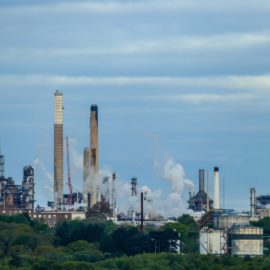
The settlement of a couple of law suits against the EPA may mean more restrictions on the emissions from plants there.
A proposed settlement of lawsuits against the EPA could further reduce toxic emissions at Denka Performance Elastomers and other plants in the area of the state that environmentalists have dubbed “Cancer Alley.” The proposed settlement involves two lawsuits filed by environmental groups against the Environmental Protection Agency. It could use the results of a new health risk assessment of chloroprene to further reduce emissions of the cancer-causing chemical at the Denka Performance Elastomers manufacturing facility in LaPlace, as well as levels of toxic ethylene oxide, formaldehyde and butadiene there and at other facilities. The proposed settlement involves two lawsuits filed by environmental groups against the Environmental Protection Agency. It could use the results of a new health risk assessment of chloroprene to further reduce emissions of the cancer-causing chemical at the Denka Performance Elastomers manufacturing facility in LaPlace, as well as levels of toxic ethylene oxide, formaldehyde and butadiene there and at other facilities. The settlement, announced in the Federal Register on Tuesday, also could result in more stringent rules for flares used to burn emissions from some plastics manufacturing facilities in Louisiana, Texas and elsewhere in the nation.
nola.comhttps://www.nola.com/news/environment/article_5256b918-e6a1-11ec-bd40-9f56f3fd37de.html
The suits asked the EPA to recheck the emissions against a higher standard.
In May 2021, the Concerned Citizens of St. John petitioned EPA to conduct an emergency review of the health and environmental risks of exposure to chloroprene, the chemical used to make neoprene, a rubberized plastic material best known for its use in making wetsuits. That same day, EPA’s own inspector general also demanded that the agency move quickly to upgrade regulation of chloroprene and also of ethylene oxide, another chemical used in plastics manufacturing, to reduce cancer risks in St. John and Ascension parishes and 16 other U.S. locations. In November 2021, Concerned Citizens, the Louisiana Environmental Action Network and the Sierra Club sued the agency to require it to upgrade its rules governing emissions of those and other toxic chemicals from similar plastics manufacturing plants. On April 7, 2022, EPA announced that it also was conducting investigations of the state Departments of Environmental Quality and Health for their actions involving permit approvals for Denka. And on March 4, EPA announced it would conduct an updated human health risk study of chloroprene at the same time it reviewed the rules governing the plastics manufacturing process.
The EPA promised to hold industry to the required limits.
In that announcement, the agency said that based on the risk assessment, it would “take appropriate action to ensure that the standards” contained in its regulations governing the manufacture of polymers and resins “continue to provide an ample margin of safety to protect human health.” “EPA’s recognition that it must perform this long overdue rulemaking is an important step along the path toward finally strengthening the protection from cancer-causing toxic air that community members in St. John have been breathing for years,” said a statement released Tuesday by Concerned Citizens and LEAN. “This is an example of Biden’s EPA starting to chart a new course on environmental justice, and clean air, after years of EPA ignoring fenceline communities’ daily reality of being overwhelmed by cancer-causing pollution. “The ultimate test will be whether EPA listens to St. John community members, follows the science and strengthens air toxics standards to protect public health. Facilities’ emissions of chloroprene and other extremely toxic chemicals are especially hazardous to children’s health and well-being and need immediate attention,” the statement said.
This came to a head when the EPA said that five tracts in the area were the highest in the nation for chloroprene, which meant the Denka plant.
Concerns about the Denka facility’s emissions arose in 2014, when EPA released a report saying five census tracts near the plant had the country’s highest risk of cancer because of exposure to airborne emissions. The plant, owned by Tokyo-based Denka Co., is the only one in the nation that emits chloroprene. Concerned Citizens has been pushing EPA to reduce emissions from the plant since then, and has been partially successful. In early 2017, Denka entered into a voluntary agreement with the Louisiana Department of Environmental Quality to dramatically reduce emissions from the plant, at a cost of about $17 million. But in 2016, EPA recommended that levels of chloroprene at monitors around the facility should be no more than an annual average of 0.2 micrograms per cubic meter. Between January 6 and April 14 of this year, EPA found that average levels at all 18 monitors around the plant remained above that goal, with the highest level measured at 1.67 micrograms per cubic meter. Despite its efforts to reduce emissions, Denka still insists that EPA’s risk assessment is wrong, and points to Louisiana Tumor Registry data to contend levels of cancer near the plant do not reflect the EPA assessment.
The second suit involved the Clean Air Act.
The second settlement agreement involves a separate lawsuit filed against EPA in October 2020 by a number of national and local environmental groups, including many in Houston, that said the agency had violated a Clean Air Act requirement that it review the regulations governing flares used to burn air emissions at chemical plants that make polymers and resins used in plastic manufacturing every eight years. The groups filing that suit were the Environmental Integrity Project, Clean Air Council, Air Alliance Houston, Chesapeake Climate Action Network, Earthworks, Environment America, Environment Texas, Hoosier Environmental Council, PennEnvironment, and Texas Campaign for the Environment. The groups contend that flares at the chemical plants should follow regulations at least as stringent in reducing air emissions of toxic chemicals as those required by EPA of oil refineries in 2015. Judge Trevor McFadden, with the U.S. District Court in Washington, D.C., last year ordered the two lawsuits to be merged. The settlement announced Tuesday includes two separate proposed settlement agreements, which must both be approved by McFadden after a public comment period that will end on July 7. Public comments can be submitted online at https://www.regulations.gov by searching for Docket ID No. EPA-HQ-OGC-2022-0403. A copy of the Federal Register notice and the two settlement agreements also can be found there.
At any rate, the hoped for changes are two years off.
As part of the Concerned Citizens settlement agreement, EPA has agreed to submit a proposed rule based on the new health risk assessment no later than March 31, 2023, with a final rule put in place by March 29, 2024. The second suit settlement requires EPA to determine whether new standards are required for emissions from volatile organic liquid storage vessels at the polymer and resin facilities by Sept. 28, 2023, and if a rule is required, the final rule must be enacted by Sept. 30, 2024. Regulations governing flares at epoxy resin and non-nylon polyamides production facilities must be proposed by March 31, 2023, and a final rule must be in place by March 29, 2024. EPA will be given more time to consider revisions of rules for marine tank loading operations, with a proposed rule due by Dec. 19, 2025, and a final rule no later than Dec. 18, 2026. The settlement agreement also allows delays in those deadlines, on a day-for-day basis, if Congress fails to provide EPA with enough money to complete the rulemaking process.
No matter the improvements, the air will still be bad.



